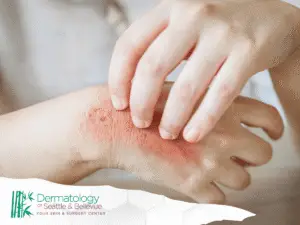Noticing a mole that looks or feels different can raise immediate concerns—and understandably so. With rising awareness of melanoma skin cancer, it’s natural to wonder: how can I tell if a mole is cancerous or just a normal mole? The truth lies in understanding the warning signs, knowing your own skin, and recognizing when it’s time to take action.
Quick Summary
- Normal moles are usually round or oval with smooth borders, uniform color, under 6mm, and remain stable over time.
- Suspicious moles often follow the ABCDE warning signs: asymmetry, irregular borders, color variation, diameter over 6mm, and evolution (any change, bleeding, itching, crusting, or pain).
- Use the “ugly duckling” rule and perform monthly full-body skin checks, including scalp, behind ears, palms/soles, between toes, and under nails.
- See a dermatologist for any new or changing mole, a spot that bleeds or won’t heal, persistent itching/burning/tenderness, or unusual dark spots on palms/soles or under a nail.
- Diagnosis may involve dermoscopy or a skin biopsy; treatment commonly includes surgical removal (excision or Mohs), followed by regular follow-ups and strict sun protection (SPF 30+, avoid tanning beds, protective clothing).
This guide will help you distinguish between normal moles and potential red flags, highlight key symptoms, and walk you through when to see a dermatologist.
What is a Mole?
A mole—also called a nevus—is a common growth made up of melanocytes, the skin cells responsible for producing pigment. Most people have between 10 and 40 moles scattered across various areas of the body, and the majority are completely harmless.
Moles can appear at birth or develop during childhood and adolescence. Some may even change slightly with age, especially in response to hormonal changes or sun exposure. Understanding how a normal mole behaves is essential to spotting abnormalities early.
Normal Mole Characteristics
Recognizing what a normal mole looks like is your first line of defense in spotting melanoma. Though they vary slightly from person to person, most healthy moles share these features:
- Shape: Round or oval with smooth, even edges
- Color: Uniform in color—often brown, tan, or flesh-toned
- Size: Typically smaller than a pencil eraser (under 6mm in diameter)
- Texture: Flat or slightly raised, smooth to the touch
- Stability: Doesn’t change in color, shape, or size over time
If your mole fits these traits, chances are it’s harmless. But if something seems off, it could be a warning worth checking out.
Signs of a Suspicious Mole
A mole that looks different from the rest, changes over time, or develops unusual symptoms could signal melanoma or another form of skin cancer. While not every irregular spot is dangerous, knowing the visual and physical warning signs helps you catch issues early. It’s important to pay attention to changes in moles, such as increased size, color variations, or irregular borders. Additionally, the presence of itchy moles and skin cancer risk should not be overlooked, as persistent itchiness can indicate underlying problems. Regular skin checks and consultations with a dermatologist are crucial for early detection and effective treatment.
Experts often refer to the “ugly duckling” rule—if one mole stands out from all the others in appearance, it’s worth a closer look. The next few sections will explore key traits to watch for.
Asymmetry
Asymmetry means one half of the mole doesn’t match the other. A normal mole is typically symmetrical in shape, while a cancerous lesion may appear uneven, lopsided, or oddly formed.
This visual imbalance is one of the earliest and most reliable warning signs of melanoma, especially when seen alongside other abnormalities.
Border Irregularity
The border or edges of a mole can offer valuable clues. While normal moles tend to have smooth, well-defined borders, a suspicious spot may show jagged, scalloped, or blurred edges.
Uneven borders can be a sign that the skin cells are growing in an uncontrolled way—one of the hallmarks of melanoma skin cancer.
Color Variation
A normal mole usually has a consistent color, typically brown or flesh-toned. But if you notice a mole that contains different shades of tan, black, red, white, or even blue, it could be a warning sign of melanoma.
Color changes often point to irregular pigment production or inflammation beneath the skin, which may indicate abnormal cell activity. This is especially concerning when color variation appears suddenly or spreads unevenly across the spot.
Diameter
Size also matters. Most harmless moles are smaller than 6 millimeters (about the size of a pencil eraser). A spot larger than this—especially if it continues growing—is something to pay attention to.
Here are a few red flags related to diameter:
- A mole noticeably larger than others
- Recent or rapid growth in size
- A dark or irregular spot expanding past its original borders
- Increase in elevation or thickness
Not all large moles are cancerous, but size combined with other signs often warrants a closer look.
Evolution
The “E” in the ABCDE Rule stands for evolving, which refers to any change in the mole’s size, shape, color, or symptoms over time. This could mean the spot begins to bleed, itch, crust, or become painful.
Evolution is one of the most important warning signs of melanoma, as even subtle differences over weeks or months can indicate developing cancer.
Steps to Self-Examine a Mole
Self-exams are a vital part of early skin cancer detection. By taking a few minutes each month to inspect your skin, you increase your chances of catching melanoma before it progresses. These exams are especially important for people with multiple moles, a history of sun exposure, or known risk factors.
Consistency is key—knowing what’s normal for your body helps you recognize changes quickly.
ABCDE Rule
The ABCDE Rule is a widely used guide to identify potential melanoma skin cancer. Here’s what to look for:
- Asymmetry – One half doesn’t match the other
- Border – Irregular, scalloped, or poorly defined edges
- Color – Multiple colors or uneven shades
- Diameter – Larger than 6mm
- Evolving – Any noticeable change in size, color, shape, or symptoms
Spotting just one of these signs can be enough to justify further evaluation by a dermatologist.
Monthly Skin Checks
Performing a full-body skin check once a month allows you to monitor for new or changing moles. Use a mirror (or a partner’s help) to inspect all areas—including your palms, soles, between your toes, and under your fingernails or toenails. In addition to your monthly checks, dermatologists often emphasize the importance of regular professional skin examinations, especially if you have a family history of skin cancer. Following mole check frequency recommendations can help catch any potential issues early, leading to better outcomes. Remember that early detection is key, so don’t hesitate to consult a healthcare professional if you notice any changes.
Don’t forget:
- The scalp (part your hair to check)
- Behind the ears
- The back and buttocks
If you spot a dark or strange-looking spot that stands out—especially one that fits the ugly duckling rule—note it and follow up.
When to Seek Professional Help
Even if you’re confident in doing monthly skin checks, nothing replaces the expertise of a dermatologist. Some melanoma cases are subtle, painless, or appear in places that are easy to overlook. If you’re ever uncertain about a mole, don’t wait—book a dermatologist appointment for peace of mind and proper evaluation.
Early detection drastically improves the success of treatment, especially with melanoma skin cancer.
Dermatologist Appointment
If you’ve noticed any of the following, it’s time to schedule a visit:
- A new or evolving mole
- A spot that bleeds, scabs, or doesn’t heal
- A mole with irregular color, edges, or shape
- Persistent itching, burning, or tenderness around a mole
- An unusual dark spot on the soles, palms, or under a nail
Bringing up any symptoms early can make a major difference. A quick evaluation could rule out cancer—or help catch it before it spreads.
Diagnostic Procedures
If a dermatologist suspects a mole may be cancerous, they’ll take further steps to confirm the diagnosis. Thankfully, dermatology offers several tools that allow for accurate and minimally invasive testing.
Two of the most common diagnostic techniques are skin biopsies and dermoscopy, both of which help determine whether a spot is benign or needs further action.
Skin Biopsy
A skin biopsy is the most definitive way to determine whether a mole is cancerous. During the procedure, a dermatologist removes a small sample (or the entire spot) for lab testing. The results help identify the type of cancer, such as melanoma, basal cell carcinoma, or another variant.
Biopsies are quick, usually done with local anesthesia, and provide essential clarity for guiding appropriate treatment.
Dermoscopy
Dermoscopy is a non-invasive diagnostic method that allows doctors to examine the skin with a magnifying tool called a dermatoscope. It reveals patterns and colors below the surface that aren’t visible to the naked eye.
This technique helps dermatologists identify subtle signs of melanoma or other skin abnormalities, especially in moles that are borderline suspicious but not clearly dangerous.
Treatment Options
If a mole is diagnosed as melanoma or another form of skin cancer, treatment usually begins quickly. The primary goal is to remove the abnormal tissue and prevent it from spreading further.
Treatment plans vary based on the type, size, and depth of the cancer, but most are effective—especially when caught early.
Removal of Malignant Moles
For melanoma and other forms of skin cancer, surgical removal is usually the first step. The goal is to eliminate the mole along with a margin of healthy skin around it to ensure all cancer cells are gone.
Common removal methods include:
- Excision – cutting out the mole and some surrounding tissue
- Mohs surgery – a precise technique for certain types of skin cancer, especially on sensitive or high-risk areas
- Laser or cryotherapy – sometimes used for superficial lesions or in cosmetic treatment of non-cancerous moles
Surgical procedures are typically done in-office with minimal recovery time.
Follow-Up Care
Even after successful treatment, follow-up is critical. Patients diagnosed with melanoma or other skin cancers are often advised to return for regular checkups to monitor for recurrence or new warning signs.
Ongoing follow-up may include:
- Skin exams every 3–12 months depending on your risk level
- Imaging or lab tests in advanced cases
- Lifestyle adjustments, including strict sun protection
Being proactive with follow-up care boosts long-term outcomes and keeps your skin health on track.
Importance of Sun Protection
Even though not all melanomas are caused by sun exposure, many are—and preventing damage to your skin remains essential. Daily use of sunscreen, avoiding tanning beds, and wearing protective clothing all reduce your chances of developing abnormal moles or skin cancer.
Apply SPF 30 or higher, even on cloudy days, and reapply during long exposure. Your future self will thank you.
Risk Factors for Developing Malignant Moles
Some people are more likely to develop melanoma or other dangerous moles. These risk factors include:
- Family history of skin cancer
- Having many moles or atypical moles
- Fair skin, freckles, red or blonde hair
- Severe sunburns, especially in childhood
- A compromised immune system
Being aware of these risk factors allows for more informed prevention and earlier detection.
Lifestyle Changes for Skin Health
Maintaining healthy skin means more than just avoiding sunburn. Incorporate these simple changes into your routine:
- Perform monthly self-exams
- Book yearly full-body skin checks with a dermatologist
- Limit sun exposure, especially during peak hours
- Quit indoor tanning for good
- Wear protective gear when outdoors
Healthy habits now can mean fewer problems later.





